|
Vol. 227 No. 7 |
| |
 |
Fishing in the subsea BOP
DP has its limits. A disconnect was required that resulted in a small fish and a unique way to solve the problem.
Tim Burns, John Shaughnessy, and Brett Cocales, BP
BP recently had to overcome a unique subsea fishing problem in 6,838 ft of water in the Gulf of Mexico. While drilling with a dynamically positioned (DP) semi-submersible drilling rig, the operator used available technology to recover a fish (piece of drill pipe) that, in years’ past, would have not been recoverable. While the operation was time consuming and costly, attempting to move forward without recovery could have resulted in the well being lost or significant subsea equipment damage.
BACKGROUND
A DP rig (Fig. 1) stays on location with computer controlled thrusters that keep it over the well. A subsea BOP is connected to the well with a hydraulically controlled clamp, Fig. 2. The BOP has six rams. Three are pipe rams that are designed to close around the drill pipe to prevent formation fluids from escaping, in the event that the drilling mud is insufficient to control the horizons being drilled. Two rams are blind/ shear, designed to cut drill pipe and seal the wellbore. One ram is designed to cut the casing.
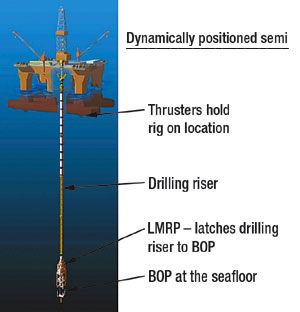 |
Fig. 1. Typical dynamically positioned semi and BOP arrangement.
|
|
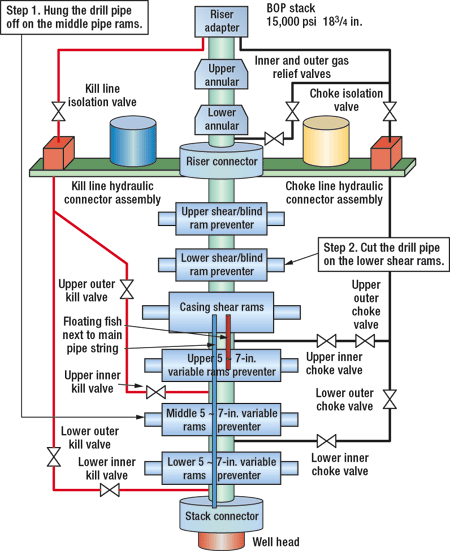 |
Fig. 2. Schematic of BOP, order of pipe shear activation, and resulting positions of pipes.
|
|
When a DP rig is overpowered by the weather (or loses power), it is necessary to disconnect the lower marine riser package (LMRP) that attaches the marine drilling riser to the BOP. If the rig does not disconnect during excessive weather, the riser, BOP and, subsequently, the wellbore, can be damaged or lost. If the rig is drilling when an emergency disconnect is necessary, the automatic procedure is:
- Pick up drill pipe and hang off a tool joint on a closed BOP ram (to secure the wellbore).
- Activate the BOP shear rams to cut the drill pipe.
- Close valves to secure and protect the wellbore.
- Release the LMRP (so as not to stress the subsea system).
- Allow environmental forces to move the rig away from the wellbore.
The above sequence is designed to be done in about one minute. The subsea BOP and riser could otherwise be subjected to the weather load and damaged if the rig cannot resist the wind, waves and currents. The need for an emergency disconnect is rare. In most cases, the recovery time (return to productive work) would be four to seven days. If the subsea equipment is damaged – by not disconnecting – the recovery time could be several months.
Rigs in the Gulf of Mexico frequently have to deal with loop currents, which are associated with the Gulf Stream between the Yucatan Peninsula, Florida and Cuba. Loop currents can result in water flow up to 4 knots. Eddies are high-current areas that can rotate for months after disconnecting from the main loop current. While not as strong as the main loop, these eddies can still apply significant force on drilling rigs. Figure 3 is a sketch showing the loop current path in the Gulf of Mexico. These are constantly monitored to prepare the rig for their force.
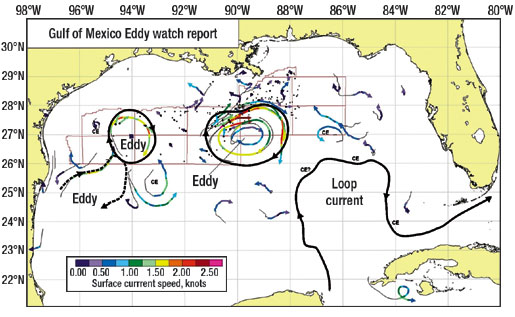 |
Fig. 3. Loop currents and eddies need to be constantly watched. Some have water flow up to 4 knots.
|
|
THE DP INCIDENT
On BP’s operation, at a critical time, the wind was co-linear with the eddy current, with both coming from the south. The combination of wind and current resulted in greater than 3 knots of effective current pushing the rig to the north. The rig’s environmental load, due to the weather, was requiring all available engine power to operate the rig’s thrusters to maintain position. When the rig was operating the engines at 85% capacity, the decision was made to prepare the wellbore for a possible disconnect.
Rather than wait until it was absolutely necessary, the pipe was pulled into the casing, hung off on the BOP rams and the hole secured. Next, the drilling mud was circulated out of the riser. The next step taken was to cut the drill pipe with the Lower blind/ shear rams (second ram from the top in the subsea BOP (Fig. 2).
About an hour later, the rig could no longer resist the weather forces, and the decision was made to disconnect the drilling riser. One button is pushed to execute the 36 steps of the emergency disconnect procedure.
By taking the earlier steps to prepare for the disconnect, two potentially significant problems were avoided. Pulling the bit and drill pipe into the casing eliminated the potential of stuck pipe in the openhole. By circulating out the drilling mud from the riser, the environmental impact of a 2,000 bbl spill was avoided. Also, the value of the recovered mud was realized.
THE PROBLEM
Within 18 hours of disconnect, the rig was ready to resume productive work. The LMRP was re-attached to the BOP. An overshot (designed to latch onto the cut drill pipe) was run to where the pipe was cut. However, the pipe was encountered 41D2-ft deeper than expected in the subsea BOP. It was known that the Lower shear rams had functioned (as intended) because of the length of cut drill pipe recovered. The only reason a deeper pipe “top” was encountered would be because of a second, unplanned, shear-ram function.
It was determined that the Casing shear rams (third cavity, Fig. 2) functioned when the emergency disconnect sequence was made. Thus, a 41D2-ft piece of drill pipe was cut off the top of 10 ft of drill pipe above the middle pipe rams, where the drill pipe was hung off. This “floating fish,” i.e., unsecured, fell down next to the primary drill string, which was hung off (Fig. 2, red fish).
Fishing operations are routine to grab pipe hung off in the BOP. Unfortunately, grabbing the second, “floating” fish would be more difficult. The floating fish was too heavy to be picked up by a magnet. The two fish side by side were too wide to be covered by a conventional overshot, and still expect the grab to be strong enough to pull the pipe out of the well.
The BOP and riser were circulated to seawater to enable use of a 11-1/16-in. TV camera (Fig. 4), which was lowered on electric cable to send back a picture of the problem inside the subsea BOP. This was the first confirmation that two fish were side by side, Fig. 5.
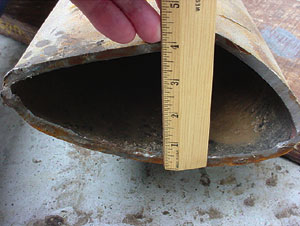 |
Fig. 4. Downhole TV camera elements.
|
|
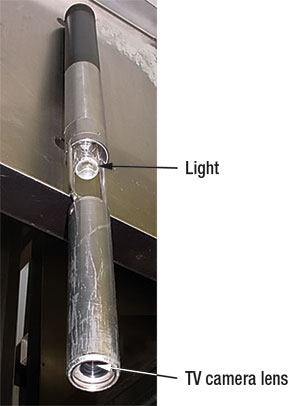 |
Fig. 5. Confirmation that there was a fish next to main drill pipe.
|
|
THE SOLUTION
When drill pipe has to be cut by the subsea BOP shear rams, it is usually pinched (Fig. 6) on the end that was cut. If an overshot grapple cannot go over that “pinched” pipe, a mill is run to “burn” (or wear) off the pinched metal to get down to round pipe. A concave mill was run in an attempt to better prepare the pinched pipe for fishing. At this point, the presence of the second, floating fish was unknown, and the act of burning (or milling) created a new problem. A portion of the floating fish was sliced from the edge of the drill pipe, Fig. 7. This would become a flap of steel, 12-in. long, 5-in. wide and 3/8-in. thick. Before the floating fish could be recovered, the flap would have to be cut off the top to allow access with fishing tools. The flap was cut by running a burning shoe, sized large enough to burn only the outer diameter of the fish.
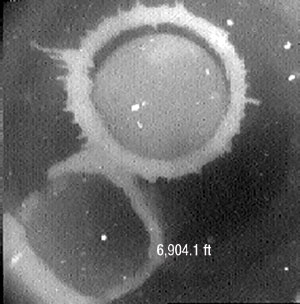 |
Fig. 6. Sheared drill pipe pulled to surface.
|
|
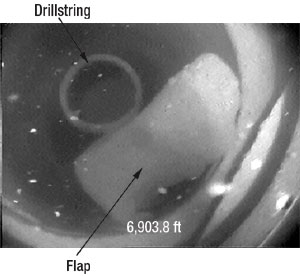 |
Fig. 7. Position of drillstring and flap, which is atop floating fish.
|
|
The floating fish was recovered by a creative team working at the rig site using common fishing tools, the TV camera and the rig’s capability to reposition itself. A spear (Fig. 8) with one joint of 3-1/2-in. drill pipe (for flexibility), was lowered onto the well. The TV camera was run inside the drill pipe to the depth of the spear. Using this camera as a visual guide, the rig was then maneuvered until the spear was on top of the floating fish.
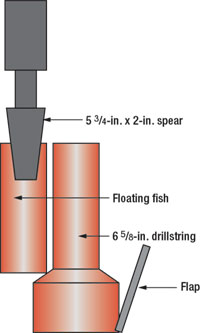 |
Fig. 8. How all the elements were arranged inside the BOP.
|
|
In normal fishing, when the pipe is lowered near a fish, it can only be moved up or down. However, a DP rig can be easily repositioned. Moving the DP rig resulted in moving the drill pipe side-to-side in the BOP’s 183D4-in. bore. The rig was repositioned in a 30-ft box pattern. Using this method and the TV camera, the spear was positioned above the floating fish. The 21D2-in. spear stabbed into the 5-in. diameter of the drill pipe 1.3-mi below. The floating fish was then successfully recovered, although with a 50,000-lb overpull, Fig. 9.
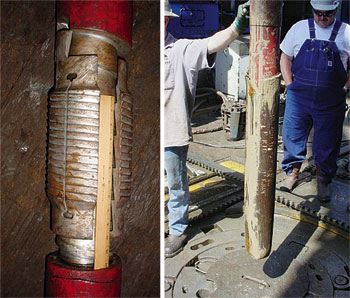 |
Fig. 9. Left, spear, and retrieval of floating fish, right.
|
|
The remaining flap of steel, milled from the floating fish, was still in the subsea BOP. The TV camera confirmed its presence, Fig. 10. A large magnet was built to go over (or swallow) the drill pipe stub and pick up the flap. Unfortunately, the magnet failed. After the drill string was latched the pipe rams were opened allowing the steel flap to fall downhole. The concern was that flap could become wedged between the drillstring and casing, which fortunately did not occur, although some overpull was observed on the trip out. The primary drillstring was recovered in a routine manner. Total time lost to the fishing operation was 12 days.
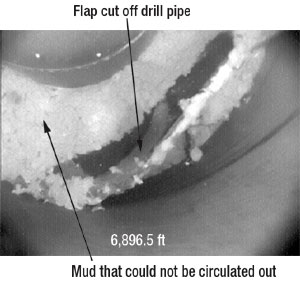 |
Fig. 10. Camera showing cut off flap. Courtesy DHV Downhole Video.
|
|
CONCLUSION
The downhole TV camera proved essential, as did the maneuverability of the DP vessel. It is clear that without the input from a varied team, innovative use of the TV camera and the dynamically positioned rig, the well could have been lost. 
THE AUTHORS
|
 |
Tim Burns is a drilling engineer for BP, currently working in Deepwater Exploration. He has 23 years of experience and has enjoyed a variety of assignments in the Gulf of Mexico, Rocky Mountains and Alaska. He has a BS degree in petroleum engineering from Louisiana Tech University.
|
|
 |
John Shaughnessy is a drilling engineer with BP America in Houston. He presently is working in Deepwater Drilling in the Gulf of Mexico. His 28 years in the industry have been with BP and Amoco, drilling along the Gulf Coast. He has worked onshore and offshore, HTHP and ultra deepwater environments. He has a BS degree in chemical engineering from the University of Pittsburgh.
|
|
 |
Brett Cocales has been working in the petroleum industry since 1990, working for companies in the operating and service areas of drilling, completion engineering and operations. He holds a BS degree in petroleum engineering from Montana Tech and an MBA from the University of Montana. He is employed by BP as a wellsite leader in the deepwater GOM.
|
| |
|
|















